Facts About Mandrill
The mandrill is a captivating primate from the Old World monkey family, specifically belonging to the genus Mandrillus, along with the drill. While they were once classified alongside baboons in the genus Papio, mandrills now hold their own distinct classification. They are closely related to Cercocebus mangabeys.
Mandrills inhabit countries such as Cameroon, Gabon, Equatorial Guinea, and Congo, primarily residing in tropical rainforests. These social animals thrive in large groups, known as hordes, and have an omnivorous diet, consuming a mix of fruits, insects, and other foodstuffs. Their mating season peaks from July to September.
As the largest monkeys in the world, mandrills are currently classified as vulnerable by the IUCN. They are easily distinguishable by their colorful fur and unique facial features. There is a notable sexual dimorphism between males and females, with males being significantly larger and exhibiting more vibrant colors. This brilliant coloration results from light diffraction in their facial collagen fibers.
In their natural habitat, mandrills form large groups and split their time between the ground and the trees. They are diurnal creatures, active during the day, and are even known to use tools. Their diverse diet includes both plant and animal matter. However, they face natural predators such as leopards, crowned eagles, and African rock pythons.
Socially, mandrills are complex. During the mating season, dominant males lead the groups. Females usually stay within their natal groups, while males tend to disperse. The mating season extends from June to October, and females exhibit sexual swellings to signal their readiness to mate. Most births occur between January and May, with females taking primary responsibility for caring for the young. Mandrills communicate through a variety of vocalizations and behaviors.
Unfortunately, mandrills are threatened by deforestation and hunting for bushmeat, which has contributed to their vulnerable status. Conservation efforts, including captive breeding programs and successful reintroduction initiatives, are in place to help protect and preserve these remarkable primates.

 Gabon
Gabon